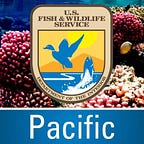Lāʻau lapaʻau: Reclaiming Traditional Practices of Medicine
By Nanea Valeros, Public Affairs Specialist, U.S. Fish and Wildlife Service
Native plants play an important role in Hawaiian culture. For example, they are used to make lei, hula implements, and poi-pounding boards; used in ceremony; used for weaving and making cloth; and used for physical and spiritual healing, which is called lāʻau lapaʻau. Lāʻau lapaʻau is the traditional practice of physical and spiritual healing through the use of plants. In Hawaiian culture, spiritual healing is just as important as physical healing.
Lāʻau lapaʻau was outlawed in 1820 upon the arrival of missionaries to Hawaiʻi. The arrival of foreigners also meant the introduction of foreign diseases — diseases Native Hawaiians had no immunity against. These diseases ultimately caused the decline of the Native Hawaiian population, and the people of Hawaiʻi were not allowed to heal physically or spiritually by the practices of their kūpuna (ancestors).
Kamehameha V legalized lāʻau lapaʻau 50 years later; however, by that time too much knowledge had been lost. Western medicine was the only means by which to fight these foreign diseases. Not to say that Western medicine hurt the Hawaiian people; in fact, it did the opposite. It wasn’t until the smallpox vaccine was mandated, that deaths started to decline. Furthermore, after a fourth smallpox epidemic was introduced, Liliʻuokalani was able to mandate stay-at-home orders and stop travel, which successfully confined the epidemic (that lasted five months) to Oʻahu. She was able to stand firm in the face of difficulties and get her people through a very tough time.
Health isn’t only physical though; it’s also spiritual. Native Hawaiians were essentially prohibited from practicing physical and spiritual healing through lāʻau lapaʻau for half a century. One cannot fully comprehend the effects this ban must have had on Native Hawaiians who lived at that time, and the generations that followed.
In 1988, Congress passed the Native Hawaiian Health Care Act which recognizes lāʻau lapaʻau as traditional medicine. Furthermore, cultural practitioners of Papa Ola Lokahi, the Native Hawaiian Health Board, are able to work independent from state government oversight. This is important as many traditional practices, such as lāʻau lapaʻau, are sacred and are handed down through ʻohana (families) and elders.
One plant that is used for lāʻau lapaʻau is ʻōlena (Curcuma longa). When the rhizome (root stalk) is pounded and strained, the liquid can be used to treat ear infection, respiratory infection, and inflammation. It is most commonly made into tea and many people drink it for a number of health benefits including to improve blood circulation, digestion, and immunity.
Another plant used for lāʻau lapaʻau is ʻaʻaliʻi (Dodonaea viscosa). The leaves of the plant are ground to a paste and applied to rashes and skin diseases for relief. The leaves can also be chewed to relieve toothaches. ʻAʻaliʻi, as a pioneer species, is very hardy and also represents resiliency in Hawaiian culture. He ʻaʻaliʻi kū makani mai au; ʻaʻohe makani nana e kulaʻi — I am a wind-resisting ʻaʻaliʻi; no gale can push me over. This ʻōlelo noʻeau reminds you to ʻonipaʻa (stand firm) in the face of difficulties, like the ʻaʻaliʻi and like Liliʻuokalani. ʻOnipaʻa was actually her motto. She lived it, lead by example, and always encouraged her people to stand firm in times of adversity. The ʻaʻaliʻi can stand the strongest winds, twisting and bending but rarely breaks or falls over. When it does get taken by lava, it’s not long before it pops back up.
Conservation of native plants in Hawaiʻi is ecologically important as native plants provide habitat for native species; but it is also culturally important as Native Hawaiians are working to reclaim traditional practices like lāʻau lapaʻau as an essential component of health care for their ʻohana. Making sure there’s a future for native plants in Hawaiʻi helps to ensure a future for traditional practices, like lāʻau lapaʻau, that rely on native plants.
The U.S. Fish and Wildlife Service works with others to conserve, protect, and enhance fish, wildlife, plants, and their habitats for the continuing benefit of the American people. For more information, connect with us through any of these social media channels at https://www.facebook.com/PacificIslandsFWS, www.flickr.com/photos/usfwspacific/, or www.twitter.com/USFWSPacific.
